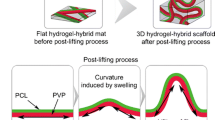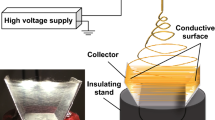Abstract
Electrospinning was used in innovative electrospinning rigs to obtain tubular and flat fibrous structures with controlled fiber orientation with the aim to be used as scaffolds for biomedical applications, more specifically in the tissue engineering of vascular and orthopedic grafts. Gelatine and hydroxyapatite (HA)–gelatine solutions of various compositions were tried and electrospinning of continuous fibers was maintained for gelatine and up to 0.30 g/g HA–gelatine solutions in 2,2,2-trifluoroethanol (TFE). Small diameter tubular scaffolds were electrospun with axial fiber orientation and flat scaffolds were cut from fiber mats electrospun around a wired drum substrate. The fibrous mats were crosslinked using a glutaraldehyde solution and subjected to image analysis of SEM micrographs, water swelling tests, and mechanical testing. Fiber diameter in the electrospun scaffolds could be varied depending on the feed solution concentration and composition whereas fiber orientation was affected by the processing conditions. After crosslinking, the 0.30 g/g HA–gelatine scaffolds absorbed the minimum amount of water after 48 h soaking and they had the highest Young’s modulus, 60 MPa, and highest strength, 3.9 MPa.








Similar content being viewed by others
References
Asran, A. S., S. Henning, and G. H. Michler. Poly(vinyl alcohol)-collagen-hydroxyapatite biocomposite nanofibrous scaffold: mimicking the key features of natural bone at the nanoscale level. Polymer 51:868–876, 2010.
Bank, A. J., R. F. Wilson, S. H. Kubo, J. E. Holte, T. J. Dresing, and H. Wang. Direct effects of smooth muscle relaxation and contraction on in vivo human brachial artery elastic properties. Circ. Res. 77:1008–1016, 1995.
Barbon, B., C. Militello, A. De Rossi, B. Martella, and E. Ballotta. Autologous great saphenous vein tailored graft to replace an infected prosthetic graft in the groin. Vasc. Endovasc. Surg. 41(4):358–361, 2007.
Bishop, A., C. Balazsi, J. H. C. Yang, and P.-I. Gouma. Biopolymer-hydroxyapatite composite coatings prepared by electrospinning. Polym. Adv. Technol. 17:902–906, 2006.
Bos, G. W., A. A. Poot, T. Geugeling, W. G. van Aken, and J. Feijen. Small-diameter vascular graft prostheses: current status. Arch. Physiol. Biochem. 106(2):100–115, 1998.
Bronzino, J. D. (Ed.). The Biomedical Engineering Handbook (2nd ed.), Vol. I. Boca Raton, FL: CRS Press, 2000.
Feng, L., S. H. Li, H. J. Li, J. Zhai, Y. L. Song, L. Jiang, and D. B. Zhu. Super hydrophobic surface of aligned polyacrylonitrile nanofibres. Angew. Chem. Int. Ed. 41:1221–1223, 2002.
Geroulakos, G., S. Kakkos, and D. Sellu. Autologous vein graft for aneurysm repair in a contaminated field. Eur. J. Vasc. Endovasc. Surg. 29:247–249, 2005.
Holzapfel, G. A., G. Sommer, C. T. Gasser, and P. Regitnig. Determination of layer-specific mechanical properties of human coronary arteries with nonatherosclerotic intimal thickening and related constitutive modeling. Am. J. Physiol. Heart Circ. Physiol. 289:H2048–H2058, 2005.
Huang, Z.-M., Y. Z. Zhang, S. Ramakrishma, and C. T. Lin. Electrospinning and mechanical characterisation of gelatine nanofibers. Polymer 45:5361–5368, 2004.
Ilona, B. D. Structure and Function of Elastin and Collagen. Budapest: Akademiaai Kiado, 1966.
Ishaug, S. L., G. M. Crane, M. J. Miller, A. W. Yasko, M. J. Yaszemski, and A. G. Mikos. Bone formation by three-dimensional stromal osteoblast culture in biodegradable polymer scaffolds. J. Biomed. Mater. Res. 36:17–28, 1997.
Jung, Y., S.-S. Kim, Y. H. Kim, S.-H. Kim, B.-S. Kim, S. Kim, C. Y. Choi, and S. H. Kim. A poly(lactic acid)/calcium metaphosphate composite for bone tissue engineering. Biomaterials 26:6314–6322, 2005.
Kasuga, T., Y. Ota, M. Nogami, and Y. Abe. Preparation and mechanical properties of polylactic acid composites containing hydroxyapatite fibers. Biomaterials 22:19–23, 2001.
Lamprou, D., P. Zhdan, F. Labeed, and C. Lekakou. Gelatine and gelatine/elastin nanocomposites for vascular grafts: processing and characterisation. J. Biomater. Appl. 2010 (online).
Lekakou, C., D. Lamprou, U. Vidyarthi, E. Karopoulou, and P. Zhdan. Structural hierarchy of biomimetic materials for tissue engineered vascular and orthopaedic grafts. J. Biomed. Mater. Res. Part B: Appl. Biomater. 85B(2):461–468, 2008.
Lekakou, C., P. Wilson, Y. C. Chau, and A. A. Salifu. Electrospinning of polymer nanocomposites. In: Proc. ICCM17, Edinburg, 2009.
L’Heureux, N., J.-C. Stoclet, F. A. Auger, G. J.-L. Lagaud, L. Germain, and R. Andriantsitohaina. A human tissue-engineered vascular media: a new model for pharmacological studies of contractile responses. FASEB J. 15:515–524, 2001.
Levick, J. R. An Introduction to Cardiovascular Physiology (3rd ed.). Oxford: Oxford University Press, 2000.
Li, W.-J., C. T. Laurencin, E. J. Caterson, R. S. Tuan, and F. K. Ko. Electrospun nanofibrous structure: a novel scaffold for tissue engineering. J. Biomed. Mater. Res. 60:613–621, 2002.
Ma, J., X. He, and E. Jabbari. Osteogenic differentiation of marrow stromal cells on random and aligned electrospun poly(L-lactide) nanofibers. Ann. Biomed. Eng. 31(1):14–25, 2011.
Marieb, E. N. Human Anatomy and Physiology. The Benjamin/Cummings Series in the Life Sciences (3rd ed.). Reading, MA: Benjamin-Cummings Pub Co, 1995.
Mikos, A. G., Y. Bao, L. G. Cima, D. E. Ingber, J. P. Vacanti, and R. Langer. Preparation of poly(glycolic acid) bonded fibre structures for cell attachment and transplantation. J. Biomed. Mater. Res. 27:183–189, 1993.
Mikos, A. G., A. J. Thorsen, L. A. Czerwonka, Y. Bao, R. Langer, D. N. Winslow, and J. P. Vacanti. Preparation and characterisation of poly(L-lactic acid) foams. Polymer 35:1068–1077, 1994.
Mouthuy, P.-A., H. Ye, J. Triffitt, G. Oommen, and Z. Cui. Physico-chemical characterization of functional electrospun scaffolds for bone and cartilage tissue engineering. Proc. IMechE Part H: J. Eng. Med. 224:1401–1414, 2010.
Ondarcuhu, T., and C. Joachim. Drawing a single nanofibre over hundreds of microns. Europhys. Lett. 42:215–220, 1998.
O’Rourke, M. F. Arterial Function in Health and Disease. London: Churchill Livingstone, 1982.
Rainer, A., C. Spadaccio, P. Sedati, F. De Marco, S. Carotti, M. Lusini, G. Yadala, A. Di Martino, S. Morini, M. Chello, E. Covino, V. Denaro, and M. Trombetta. Electrospun hydroxyapatite-functionalized PLLA scaffold: potential applications in sternal bone healing. Ann. Biomed. Eng. 2011 (online).
Rentsch, B., A. Hofmann, A. Breier, C. Rentsch, and D. Scharnweber. Embroidered and surface modified polycaprolactone-co-lactide scaffolds as bone substitute: in vitro characterization. Ann. Biomed. Eng. 37(10):2118–2128, 2009.
Sayers, R. D., S. Raptis, M. Berce, and J. H. Miller. Long-term results of femorotibial bypass with vein or polytetrafluoroethylene. Br. J. Surg. 85:934–938, 1998.
Shang, S., F. Yang, X. Cheng, X. F. Walboomers, and J. A. Jansen. The effect of electrospun fibre alignment on the behaviour of rat periodontal ligament cells. Eur. Cells Mater. 19:180–192, 2010.
Smith, L. A., and P. X. Ma. Nano-fibrous scaffolds for tissue engineering. Colloids Surf. B 39:125–131, 2004.
Solomon, E. P. Human Anatomy and Physiology (2nd ed.). London, Philadelphia (PA): Saunders College, 1995.
Teo, W. E., and S. Ramakrishna. A review on electrospinning design and nanofibre assemblies. Nanotechnology 17:R89–R106, 2006.
Tortora, G. J., and S. R. Grabowski. Principles of Anatomy and Physiology (8th ed.). New York: HarperCollins College, 1996.
Vidyarthi, U., P. Zhdan, C. Gravanis, and C. Lekakou. Gelatine-hydroxyapatite nanocomposites for orthopaedic applications. In: Current Themes in Engineering Science 2007, Vol. 1045, pp. 81–90, 2008.
Whitesides, G. M., and M. Boncheva. Beyond molecules: self-assembly of mesoscopic and macroscopic components. Proc. Natl. Acad. Sci. USA 99:4769–4774, 2002.
Williams, M. R., T. Mikulin, J. Lemberger, B. R. Hopkinson, and G. S. Makin. Five year experience using PTFE vascular grafts for lower limb ischaemia. Ann. R. Coll. Surg. Engl. 67:152–155, 1985.
Zhang, Y., H. Ouyang, C. T. Lim, S. Ramakrishna, and Z.-M. Huang. Electrospinning of gelatin fibres and gelatin/PCL composite fibrous scaffolds. J. Biomed. Mater. Res. Part B: Appl. Biomater. 72B:156–165, 2005.
Zulliger, M. A., A. Rachev, and N. Stergiopoulos. A constitutive formulation of arterial mechanics including vascular smooth muscle tone. Am. J. Physiol. Heart Circ. Physiol. 287:H1335–H1343, 2004.
Author information
Authors and Affiliations
Corresponding author
Additional information
Associate Editor Jennifer West oversaw the review of this article.
Rights and permissions
About this article
Cite this article
Salifu, A.A., Nury, B.D. & Lekakou, C. Electrospinning of Nanocomposite Fibrillar Tubular and Flat Scaffolds with Controlled Fiber Orientation. Ann Biomed Eng 39, 2510–2520 (2011). https://doi.org/10.1007/s10439-011-0350-1
Received:
Accepted:
Published:
Issue Date:
DOI: https://doi.org/10.1007/s10439-011-0350-1




